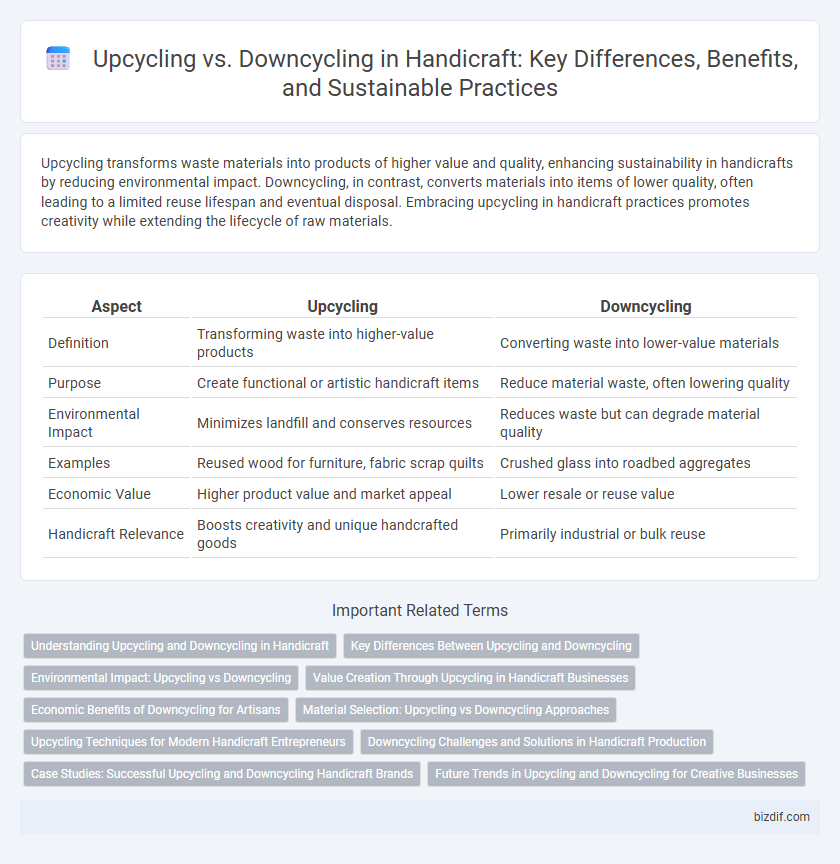Upcycling transforms waste materials into products of higher value and quality, enhancing sustainability in handicrafts by reducing environmental impact. Downcycling, in contrast, converts materials into items of lower quality, often leading to a limited reuse lifespan and eventual disposal. Embracing upcycling in handicraft practices promotes creativity while extending the lifecycle of raw materials.
Table of Comparison
| Aspect | Upcycling | Downcycling |
|---|---|---|
| Definition | Transforming waste into higher-value products | Converting waste into lower-value materials |
| Purpose | Create functional or artistic handicraft items | Reduce material waste, often lowering quality |
| Environmental Impact | Minimizes landfill and conserves resources | Reduces waste but can degrade material quality |
| Examples | Reused wood for furniture, fabric scrap quilts | Crushed glass into roadbed aggregates |
| Economic Value | Higher product value and market appeal | Lower resale or reuse value |
| Handicraft Relevance | Boosts creativity and unique handcrafted goods | Primarily industrial or bulk reuse |
Understanding Upcycling and Downcycling in Handicraft
Upcycling in handicraft involves transforming old or discarded materials into products of higher value or quality, enhancing creativity and sustainability by extending the life cycle of raw materials. Downcycling reduces the value or quality of materials by converting them into lower-grade products, often limiting reuse potential and environmental benefits. Understanding these processes helps artisans make informed choices to maximize resource efficiency and environmental impact in their craft.
Key Differences Between Upcycling and Downcycling
Upcycling transforms waste materials into products of higher value and improved quality, enhancing sustainability and aesthetics in handicrafts. Downcycling repurposes materials into new items of lesser quality or reduced functionality, often limiting their long-term usability. The key difference lies in the value retention and enhancement for upcycling versus value degradation in downcycling.
Environmental Impact: Upcycling vs Downcycling
Upcycling transforms waste materials into higher-quality products, significantly reducing landfill use and conserving resources by extending product life cycles. Downcycling, while still diverting materials from landfill, typically produces lower-quality items that are less durable and ultimately contribute to resource depletion. Emphasizing upcycling in handicraft enhances environmental sustainability by promoting waste reduction, resource efficiency, and decreased carbon emissions compared to downcycling methods.
Value Creation Through Upcycling in Handicraft Businesses
Upcycling in handicraft businesses transforms discarded materials into high-value, unique products that appeal to eco-conscious consumers, driving brand differentiation and customer loyalty. This process enhances material worth by preserving or improving original qualities, unlike downcycling, which degrades material value through lower-quality outputs. Emphasizing upcycling supports sustainable practices, reduces waste, and generates premium crafts that command higher market prices and strengthen the artisan's reputation.
Economic Benefits of Downcycling for Artisans
Downcycling offers artisans affordable access to raw materials by repurposing lower-quality waste into functional products, reducing production costs significantly. This process fosters local employment opportunities and stimulates small-scale economies by encouraging craft businesses to thrive with minimal investment. Efficient resource use through downcycling minimizes waste disposal expenses and supports sustainable economic growth in the handicraft sector.
Material Selection: Upcycling vs Downcycling Approaches
Upcycling in handicraft emphasizes selecting high-quality, durable materials that can be creatively transformed into new, valuable products, preserving or enhancing the original material's properties. Downcycling focuses on repurposing materials that have diminished quality or usability, converting them into lower-grade items with reduced functionality. Material selection in upcycling prioritizes sustainability and craftsmanship, while downcycling aims to minimize waste through practical, often industrial, reuse.
Upcycling Techniques for Modern Handicraft Entrepreneurs
Upcycling techniques enable modern handicraft entrepreneurs to transform discarded materials into high-value, unique products, enhancing sustainability and creativity within the craft industry. Methods such as fabric patchwork, repurposing vintage wood, and incorporating reclaimed metals allow artisans to minimize waste while adding aesthetic and functional value. Emphasizing eco-friendly innovation, these techniques support market differentiation and appeal to environmentally conscious consumers.
Downcycling Challenges and Solutions in Handicraft Production
Downcycling in handicraft production often leads to reduced material quality, limiting the durability and aesthetic appeal of finished products. Addressing these challenges involves integrating innovative bonding techniques and surface treatments to enhance material properties while maintaining sustainability. Employing mixed-media designs and modular components allows artisans to creatively repurpose downcycled materials without compromising functionality.
Case Studies: Successful Upcycling and Downcycling Handicraft Brands
Case studies reveal that successful upcycling handicraft brands like TerraCycle transform waste materials into high-value products, reducing environmental impact and promoting sustainability. Downcycling brands such as EcoCraft repurpose materials into lower-grade goods, offering affordability but limited durability compared to upcycled items. These examples highlight the economic and ecological benefits of strategic material reuse in the handicraft industry.
Future Trends in Upcycling and Downcycling for Creative Businesses
Future trends in upcycling highlight a surge in innovative materials and digital fabrication techniques driving creative businesses toward sustainable design solutions. Downcycling, while less favored, evolves to incorporate eco-friendly methods that extend product lifecycles, reducing environmental impact. Embracing circular economy models, artisans and designers increasingly integrate upcycling practices to meet consumer demand for unique, eco-conscious handicrafts.
Upcycling vs Downcycling Infographic

 bizdif.com
bizdif.com